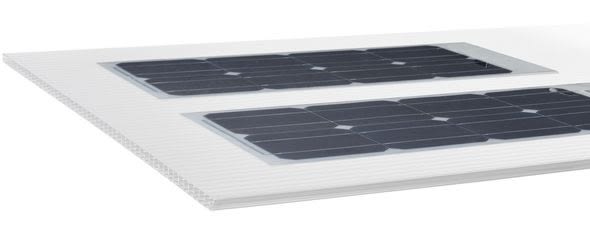 SABIC leads the curve with first polycarbonate BIPV Panels featuring design flexibility, thermal insulation & energy production in one solution.
SABIC leads the curve with first polycarbonate BIPV Panels featuring design flexibility, thermal insulation & energy production in one solution.With approximately 70 gigawatts (GW) of cumulative global installations, PV systems represent the third most important renewable energy source – after hydroelectric and wind power – in terms of capacity.
As demand for solar power rises, SABIC is helping to drive the feasibility and integration of this increasingly preferred energy source by launching today the first polycarbonate (PC) building-integrated photovoltaic (BIPV) panels for roofing, cladding and glazing applications. This new innovative solution from SABIC’s Innovative Plastics business, called Lexan BIPV panel, provides architects and builders with enhanced design freedom, thermal insulation, easy installation and energy production in a single, integrated solution.
Created through a close collaboration between SABIC and Solbian Energie Alternative, an innovative flexible photovoltaic (PV) production company, Lexan BIPV panels combine tough, lightweight, transparent Lexan Thermoclear PC sheet with flexible PV laminated crystalline cells from Solbian and are available in a broad range of structures, configurations and colors. Lexan BIVP panels demonstrate SABIC’s deep commitment to its customers by supporting the evolving trends and environmental needs for more sustainable designs while driving improved material technologies in the building and construction industry.

“The new Lexan BIPV panels show SABIC’s commitment to challenging the status quo to find better solutions and create practical innovations for customers in the building and construction industry,” said Jack Govers, SABIC general manager, Specialty Film & Sheet. “Our collaboration with Solbian has created a technology that can transform conventional roofing and glazing systems and provide new choices for the integration of solar systems into building designs across the globe. We take pride delivering the performance architects and builders expect when achieving their sustainability goals and powering their competitive advantage.”
“Our successful collaboration with SABIC has resulted in a very new, high-performance solution that will no doubt drive broader adoption of photovoltaics across many types of commercial and residential structures and geographies,” said Enrique Garcia, president, Solbian Energie Alternative.
“SABIC’s drive to constantly enhance its materials opens up new opportunities for its customers and we are happy that Solbian can contribute to this success.” The flexible photovoltaic panels from Solbian are made with monocrystalline cells with efficiency up to 23 percent, which are embedded in polymers with high-resilience technology to make them flexible. They are also highly resistant to harsh weather conditions.
One of the top benefits of Lexan BIPV panels is design freedom. Compared to traditional BIPV materials, the SABIC panels can be easily cold bended on site to form graceful, curved roofing systems integrating daylighting and photovoltaic. By using semi-transparent Lexan BIVP panel modules designers can create unique day-lighting features in façade, roofing or skylight systems.
In addition, the new panels provide high performance, beginning with excellent thermal insulation and light management that are hallmarks of Lexan Thermoclear sheet. The new panels can reduce energy consumption by up to 17 percent vs. traditional high-return, double-pane glass glazing. They help to reduce cooling load and glare associated with large expanses of architectural glazing. This virtually unbreakable, ultraviolet (UV)-protected PC material promotes safety and is exceptionally durable for long useful life.
Another important benefit of Lexan BIPV panels is light weight that can make them less expensive to transport and facilitates easy and fast assembly. Compared to heavy glass panels or standard PV panels, Lexan BIPV panels can deliver potential savings on installation time and costs. Also, the panels can be used with a lighter supporting steel framework than glass requires, which may reduce material and shipping costs.
Lexan BIPV panels are available in 10, 16, 20, 25 and 40 mm gauges, in rectangular and X wall configurations and include a color palette of clear, opal white, bronze, green, blue and gray.
The drive to reduce energy consumption is one of the highest priorities in building and construction today. Based on average material costs, green building materials represented approximately $14.5 billion in cumulative spending through 2010, and are expected to reach nearly $120 billion by 2030. BIPV panels are increasingly being incorporated into the construction of new buildings as a principal or ancillary source of electrical power, although existing buildings may be retrofitted with BIPV modules as well.
The new Lexan BIPV panels comply with the International Electrotechnical Commission (IEC) EN ISO/IEC 17025, EIC 61215 and IEC 61730-2 standard certifications and contribute to the Leadership in Energy and Environmental Design (LEED) green building certification system.
The new panels, which will be commercially available from SABIC in the second half of 2012, have already been installed at a SABIC manufacturing facility in Italy.



